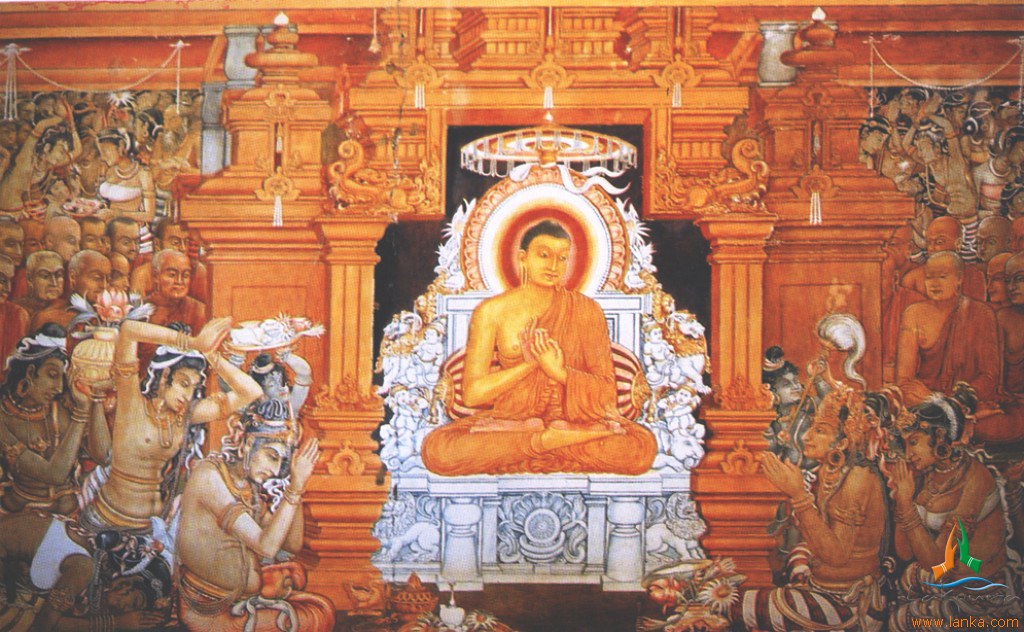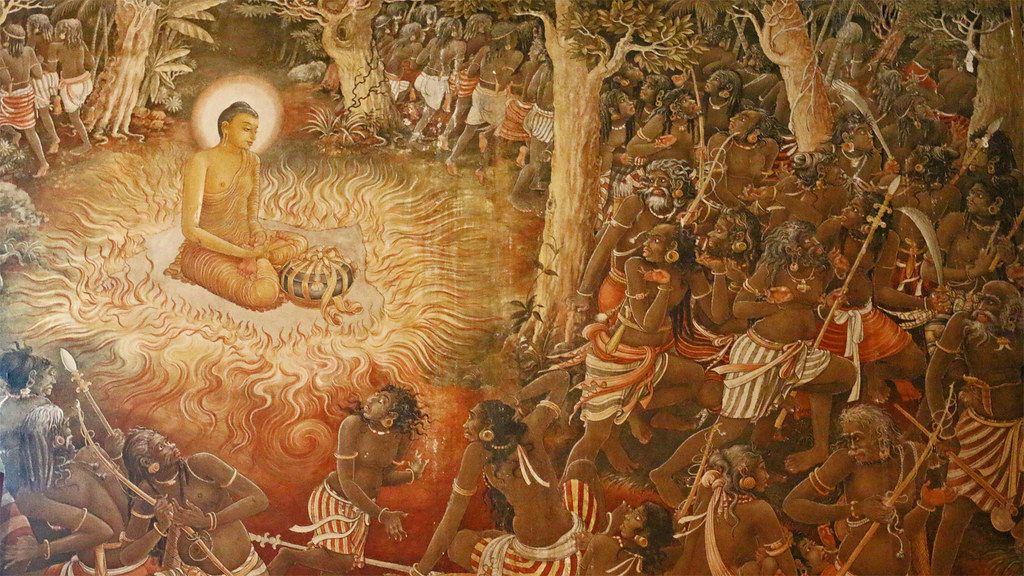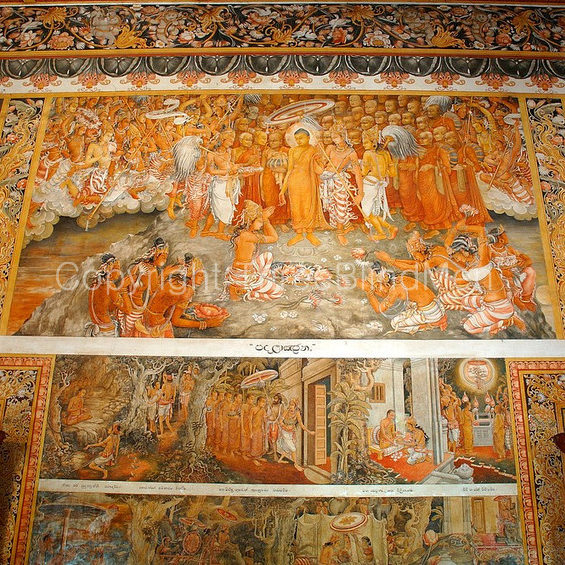පුරාණයේ සිටම සම්ප්රදාය වූයේ විහාර බිත්තිවල ජාතක කතාවලින් පින්තාරු කිරීමයි, නමුත් කැලණි විහාරය සිය නව සිතුවම් තුළ මෙම චාරිත්රයෙන් බැහැරව පිළිගැනීමක් සිදු කර ඇත. ඒ වෙනුවට එය ශ්රී ලංකාවේ බුදුදහමේ උපත, නැගීම සහ ප්රගතිය හා සම්බන්ධ ඓතිහාසික දර්ශන පෙළක් නිරූපණය කරන වර්ණාවලියක් හඳුන්වා දීමෙන් බිතුසිතුවම්වලට විවිධත්වයක් එක් කර ඇත. ඔබ විහාරයේ නව අංශයට ඇතුළු වූ විට මෙම නික්මයාම පැහැදිලිව පෙනේ.
ඔබ එහි ප්රධාන දොරටුවෙන් ප්රධාන දේවාල කාමරයට පිවිසෙන විට, කෙළින්ම ඉදිරියෙන් ඔබට පෙනෙන්නේ හතරැස් කුළුණක පිහිටුවා ඇති රන්වන් පැහැති සමාධි බුද්ධ ප්රතිමාවයි. ඊට පිටුපසින් ඇත්තේ හිමාල කඳුවැටියේ අත් අඩංගුවට ගන්නා දර්ශනයයි. මෙම කුටියට ඇතුළු වන ප්රධාන දොරටුවට ඉහළින් බිත්තියේ සිංහල ජාතියේ උපත නියෝජනය කරන බිතු සිතුවමක් ඇත. බුදුන් වහන්සේ අපවත් වන දින ශ්රී ලංකාවේ භාරකාරත්වය භාරගෙන විජය සහ ඔහුගේ අනුගාමික කණ්ඩායම ආරක්ෂා කරන ලෙස දිව්ය රාජයා වූ ශක්ර දෙවියන්ට යොමු කරන අයුරු ඔබට මෙහි දක්නට ලැබේ. ප්රතිවිරුද්ධ බිත්තියේ දකුණු කෙළවරේ එයට මුහුණ ලා ඇති පින්තූරය වන්නේ විජය කුමරු සහ ඔහුගේ අනුගාමිකයන් ලංකාවට ගොඩ බසින ආකාරයයි.

මීළඟට දේවානම්පිය තිස්ස රජු මිහිඳු මහරහතන් වහන්සේට මහාමේඝ වනෝද්යානය පිරිනැමූ අයුරු දැක්වෙන සිතුවමකි. මෙහි ඇතුන් දෙදෙනකු විසින් අඳින ලද රිදී නගුලකින් මායිම් සලකුණු කරන රජතුමාම දක්නට ලැබේ. ඊළඟට අලුවිහාරේ දී බුද්ධඝෝෂ ත්රිපිටකය ග්රන්ථගත කරන අයුරු නිරූපණය කෙරේ. බුද්ධ දේශනාව ලිඛිතව සටහන් කළ පළමු අවස්ථාව මෙයයි.
මෙම කොටසේ ඇති තවත් වැදගත් දර්ශන හතරක් නම්, බුද්ධඝෝෂ හිමියන් විසින් රචිත විසුද්දිමග්ගය, අනුරාධපුර මහා විහාරයේ සංඝරාජයට පිළිගැන්වීම, වැලිවිට සරණංකර මහ තෙරුන් වහන්සේට ඇත් රසිකයා පිළිගන්වා කීර්ති ශ්රී රජු සංඝරාජ පදවිය පිරිනැමීම ය. නිල ලාංඡනය, ථේරී සංඝමිත්තා විසින් බෝධීන් වහන්සේ වැඩම කරවීම සහ කුමාරයා විසින් දළදා වහන්සේ වැඩම කරවීම දන්ත සහ හේමමාලා කුමරිය, එය ඇගේ හිසකෙස් වල සඟවාගෙන.
මෙම කොටසේ සිංහල මෝස්තර සහ රටා කණු මත එහෙ මෙහෙ දුවයි. කැටයම් කරන ලද මල් මාලා, අභ්යන්තර කුටියෙන් ඔබ්බට ඇති මූර්ති වැඩ තිරයේ මනාව ක්රියාත්මක කර ඇත.

වම් පැත්තේ නව පිටත කුටියේ සිතුවම් සිත් ඇදගන්නාසුළු හා ආශ්වාදජනක ය. ශ්රී ලංකාවේ බුද්ධාගම ඉතිහාසයේ සහ විශේෂයෙන් කැලණිය ඉතිහාසයේ වැදගත් සිදුවීම් මෙම හුස්ම හෙළන පින්තූර සටහන් කරයි.
පුවරු වල ඉහළ තීරුවේ ඇති සිතුවම් මගින් බුදුන් වහන්සේගේ ශ්රී ලංකා සංචාරය තුනක් නිරූපණය කරයි. පහළ තීරුවේ කැලණිතිස්ස රජ සමයේ කැලණියේ මහ තෙරුන් වහන්සේ ඝාතනය කිරීම, ඒ හේතුවෙන් ඇති වූ ගංවතුර තත්ත්වය සහ දේවි කුමරියගේ බිලි පූජාව වැනි සිද්ධීන් දැක්වෙන බිතුසිතුවම් දක්නට ලැබේ.
අනෙකුත් කැපී පෙනෙන බිතු සිතුවම් වන්නේ බුරුම භික්ෂූන් වහන්සේලා පිළිබඳ ථෙරවාදී සම්ප්රදායේ පැවිදි කිරීමේ ආයතනය සහ 13 වන සියවසේ මුල් භාගයේදී මාඝ විසින් සහ 16 වන සියවසේ අගභාගයේදී පෘතුගීසීන් විසින් කැලණි විහාරයට සිදු කරන ලද කොල්ලකෑම් හා විනාශයන් පෙන්නුම් කරන ඒවාය.

